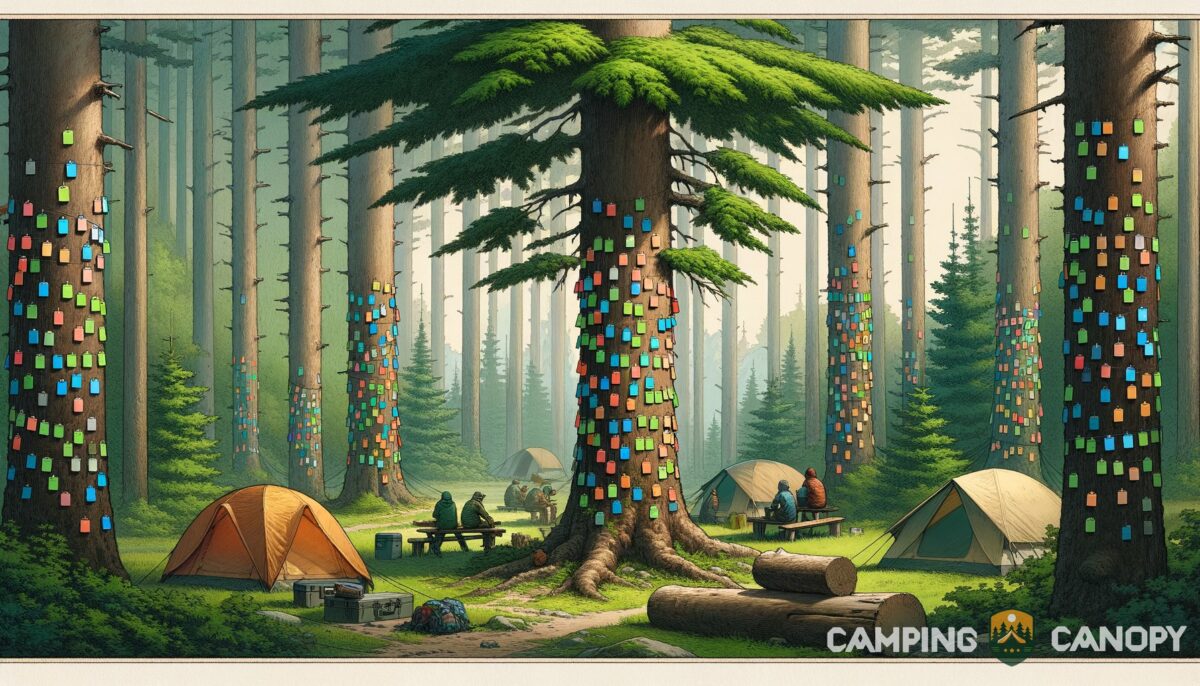On a crisp morning hike through the symphony of whispering pines, I encountered trees adorned with vivid tags, sparking my curiosity.
In this post, you’ll learn about tree-tagging and why understanding its impact is critical for any outdoor enthusiast, especially when practicing principles such as the Leave No Trace principle. Knowing what these tags represent can make us better stewards of the forest.
Key takeaways
- Tree-tagging supports scientific research and conservation efforts, aiding in the tracking and management of tree health and biodiversity.
- Respecting tagged trees and understanding their purpose is crucial for campers, hikers, and outdoor enthusiasts.
- Tagged trees play an educational role, enhancing public awareness about local ecosystems and the importance of conservation.
- Participation in tree-tagging projects can be a rewarding way to contribute to environmental preservation and connect with nature.
What does tree-tagging mean?
Tree-tagging refers to the practice of attaching tags or labels to trees for various purposes. These can range from scientific research, conservation efforts, to forest management. Boldly put, tree-tagging is pivotal for keeping tabs on tree health, growth patterns, and biodiversity conservation.
- Research and Data Collection: Scientists and researchers tag trees to monitor their health, growth rates, and responses to environmental changes. These tags usually contain information about the tree species, age, and specific data points relevant to ongoing studies.
- Conservation Efforts: In conservation areas, tagged trees might indicate species that are protected, rare, or endangered. This aids in ensuring these trees are preserved and can also help in tracking the success of reforestation efforts.
- Forest Management: For forestry operations, tree-tagging can signal which trees are slated for harvesting, treatment, or special attention due to disease or infestation concerns. This ensures sustainable forest management practices.

Understanding tree-tagging enriches our appreciation for the intricate balance of ecosystems and highlights the importance of informed and responsible camping and hiking practices. Engaging with this knowledge actively supports conservation efforts and promotes a deeper connection with the natural world.
Why is tree-tagging important?
Tree-tagging plays a significant role in environmental conservation and forest management. Its importance can’t be overstated, as it provides critical data that informs both immediate actions and long-term strategies.
Research and monitoring
Through tree-tagging, researchers can track the growth and health of individual trees over time. This information is vital for understanding how trees are adapting to climate change, which species are thriving or failing, and how different environmental factors affect forest ecosystems. It’s a cornerstone practice for gathering empirical data that guides conservation policies and actions.
Biodiversity conservation
Tree-tagging also helps in identifying and protecting biodiversity hotspots by marking trees that are part of rare or endangered species. This practice supports efforts to maintain and enhance genetic diversity within forest ecosystems, ensuring their resilience against pests, diseases, and environmental changes.

Sustainable forest management
For the forestry industry, tree-tagging is essential for sustainable management practices. It enables the selective harvesting of trees, ensuring that young, healthy trees continue to grow, contributing to the forest’s overall health and longevity. This method helps in balancing economic needs with environmental protection.
How can campers and hikers respect tagged trees?
Understanding and awareness
The first step for outdoor enthusiasts is to understand the significance of tagged trees. Recognizing that these trees may be part of scientific studies, conservation efforts, or sustainable forestry practices helps in fostering a respect for the tags and what they represent.
Do not disturb
It’s crucial for campers and hikers to avoid disturbing tagged trees. This means not removing or damaging tags, and minimizing physical contact with the tree, such as not carving into the bark or hanging hammocks and gear from tagged trees.
Spread the word
Sharing knowledge about the purpose and importance of tree-tagging with fellow campers, hikers, and the broader community can increase collective efforts to respect and protect these trees.
I will get more data to create a data table about this in the future, stay tuned.
Common misconceptions about tree-tagging
It harms the trees
Many worry that tagging can damage trees. However, when done correctly, the impact on the tree is minimal. Modern tagging methods minimize harm, using materials and techniques designed to be as non-invasive as possible.
Only unhealthy trees are tagged
This is a mistaken belief; trees are tagged for a variety of reasons, not just health concerns. Tagged trees might be perfectly healthy specimens selected for long-term growth studies or as part of biodiversity monitoring programs.
Understanding these nuances helps in appreciating the complexity and necessity of tree-tagging in forestry and conservation efforts. It underscores the collaboration between humans and nature, where even a small, colorful tag on a tree plays a part in broader environmental stewardship.
For more insights into enjoying and protecting the outdoors, exploring what camping is and how to practice the Leave No Trace principles can equip you with the knowledge needed for responsible, eco-conscious camping experiences.
How tagged trees contribute to local ecosystems
One fascinating aspect of tree-tagging that we haven’t touched on yet is its impact on local ecosystems. Beyond the scientific data collection, the presence of tagged trees within a forest or park can significantly influence the surrounding flora and fauna in unique ways.
Enhancing habitat awareness
Tagged trees usually signal areas of rich biodiversity or critical habitats, playing an unintentional role in directing conservation efforts not just for the trees themselves, but for the entire ecosystem surrounding them. This can lead to the protection of larger areas, safeguarding numerous plant and animal species.
Community engagement and education
Moreover, tagged trees usually serve as focal points for educational programs. Many parks and reserves use these tagged specimens to educate visitors about the local ecosystem, species diversity, and conservation efforts. This fosters a sense of community responsibility and involvement in preserving natural habitats.
Dos and don’ts when encountering a tagged tree
When you’re out in nature and come across a tagged tree, it’s important to know how to act responsibly. Here’s a quick guide to help you navigate these encounters with care and respect.
Dos
- Take photos of the tree and tag if it contributes to citizen science projects.
- Report any damaged or vandalized tags to the local forestry service or conservation group.
- Educate others about the importance of tree tags and what they represent.
- Maintain a reasonable distance to observe the tree without touching it or the tag.
Don’ts
- Remove or tamper with the tree tags. These are crucial for research and monitoring.
- Use tagged trees as support for hammocks or tie gear to them, which can cause harm.
- Carve, paint, or otherwise mark the tree near or around the tag area.
- Ignore signs that indicate a tagged tree is part of a conservation area with specific rules.
Influence on wildlife
Another point worth discussing is how wildlife interacts with tagged trees. Animals, from birds to mammals, might be curious about the tags, but the impact is minimal. Instead, these tags have the potential to indirectly benefit wildlife by marking trees that are part of crucial feeding or nesting areas, ensuring their protection.

A tool for connecting non-profits with conservation projects
Tree-tagging also acts as a bridge between non-profit organizations focused on conservation and specific projects or areas needing attention and resources. By identifying and sharing information about tagged trees and their significance, these organizations can more effectively allocate their efforts and resources to where they’re needed most.
Final thoughts
Tree-tagging is much more than just placing labels on trees; it’s a vital part of conservation efforts, scientific research, and community engagement to preserve our planet’s irreplaceable forests.
By understanding and respecting these tags, you contribute to a broader narrative of environmental stewardship. Let’s embrace our curiosity about the natural world responsibly, and remember to practice the Leave No Trace principles in all our outdoor adventures.
Advantages and disadvantages of tree-tagging
While tree-tagging is a critical tool for conservation and research, like all interventions in nature, it comes with its pros and cons. Understanding these can help you appreciate the complexity of working with natural ecosystems.
- Facilitates detailed tracking and monitoring of tree health and growth over time.
- Aids in the conservation of endangered species and biodiversity by marking special trees for protection.
- Supports sustainable forest management through selective tagging for harvesting.
- Engages the public and local communities in scientific research and conservation efforts.
- Potential for tags to be damaged or removed, leading to loss of valuable data.
- Improper tagging techniques or materials might cause minimal harm to the tree.
- Misinterpretation of tags by the public may lead to misunderstandings about tree health or status.
- Dependency on tagging for monitoring can overlook other vital ecological factors and interactions.
Sources and references
- N/A
















